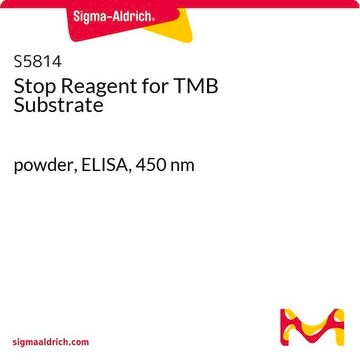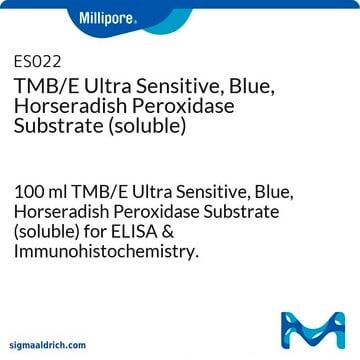T0565
3,3′,5,5′-Tetramethylbenzidine
TMB membrane substrate, chromogenic, liquid
Synonym(s):
TMB membrane substrate
Sign Into View Organizational & Contract Pricing
All Photos(1)
About This Item
UNSPSC Code:
12352204
NACRES:
NA.83
Recommended Products
product name
3,3′,5,5′-Tetramethylbenzidine (TMB) Liquid Substrate System for Membranes, ready to use solution
Quality Level
form
liquid
storage temp.
2-8°C
Related Categories
General description
3,3′,5,5′-Tetramethylbenzidine (TMB) is a chromogenic substrate for horseradish peroxidase (HRP) conjugates. It develops a permanent, insoluble, dark blue reaction product and is useful in colorimetric quantification.
Application
3,3′,5,5′-Tetramethylbenzidine (TMB) Liquid Substrate System for Membranes has been used as a chromogenic substrate in western blot analysis. It has also been used as a liquid substrate in enzyme-linked immunosorbent assay (ELISA).
3,3′,5,5′-Tetramethylbenzidine (TMB) Liquid Substrate System for Membranes has been used in:
- enzyme-linked immune absorbent spot (ELISPOT) assay
- as a substrate for IgG peroxidase
- in the visualization of immunocomplexes
Physical form
Ready-to-use.
Storage Class Code
12 - Non Combustible Liquids
WGK
WGK 3
Flash Point(F)
Not applicable
Flash Point(C)
Not applicable
Certificates of Analysis (COA)
Search for Certificates of Analysis (COA) by entering the products Lot/Batch Number. Lot and Batch Numbers can be found on a product’s label following the words ‘Lot’ or ‘Batch’.
Already Own This Product?
Find documentation for the products that you have recently purchased in the Document Library.
Customers Also Viewed
Muhammed M Salahuddin et al.
Current issues in molecular biology, 43(3), 2199-2209 (2021-12-24)
Breast cancer is the most common malignancy in women worldwide. P2X7 is a transmembrane receptor expressed in breast cancer and activated by the ATP tumor microenvironment, driving cell proliferation, angiogenesis, and metastasis via different signaling pathways. The role of the
Srdjan M Dragovic et al.
Cell host & microbe, 23(4), 523-535 (2018-04-13)
Plasmodium infection begins with the bite of an anopheline mosquito, when sporozoites along with saliva are injected into a vertebrate host. The role of the host responses to mosquito saliva components in malaria remains unclear. We observed that antisera against
Effects of nerve growth factor antagonist K252a on peritoneal mast cell degranulation: implications for rat postoperative ileus
Berdun S, et al.
American Journal of Physiology: Gastrointestinal and Liver Physiology, 309(10), G801-G806 (2015)
Hesham Saeed et al.
Protein expression and purification, 181, 105820-105820 (2021-01-14)
In previous studies Pseudomonas aeruginosal-ASNase complete coding sequence gene, 984 bp (GenBank accession number KU161101.2) was isolated by PCR, cloned into pET28a(+) vector, expressed in E. coli DE3(BL21) pLysS, purified to apparent homogeneity and biochemically characterized. In the present work
Navilla Apú et al.
Open life sciences, 18(1), 20220577-20220577 (2023-08-17)
Most laboratory tests to detect the presence of anti-SARS-CoV-2 antibodies use enzyme-linked immunosorbent assays (ELISA) or chemiluminescence immunoassays (CLIA); however, equipment for these immunoassays is unavailable in many areas of low- and middle-income countries. Rapid lateral flow immunoassay (LFIA) tests
Our team of scientists has experience in all areas of research including Life Science, Material Science, Chemical Synthesis, Chromatography, Analytical and many others.
Contact Technical Service










